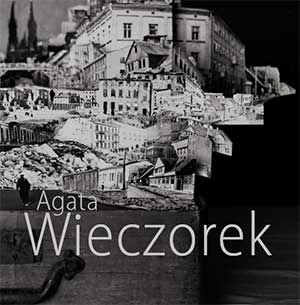 |
|
Agata Wieczorek »
fotografia, obiekt, grafika


Unmasking space
One of the features characteristic of Agata Wieczorek’s artwork is its
theatricality. Some works of the young artist, particularly those where
the world is built in ‘layers’, relate to that paradigm in a direct way. Like in
stage decorations, full of scenery flats and practicables, closed by a remote
horizon, planes develop in space, building the impression of depth. On
the one hand, cut out objects, photographed, with shiny profiles, create
a credible image of a given place. On the other hand, they make an
impression of a territory which is unreal and mysterious. In the background
of this eye-catching imagery stay, sometimes uninviting, sentimental views
of streets and backyards from £ód¼.
The above mentioned unsettling feelings are even strengthened by the fact
that in this world of created maquettes few human figures are depicted
in a simplified manner. Not only because when the scale of the image
minimises the elements of reality, it conceals numerous details seen from the
distance, but probably because the artist’s intention is not to draft in her works
the images of people with definite personality and psyche, but rather to
build signs of figures in a specific situation, representatives of some definite
types, characteristic behaviours and historical situations, systems of values.
In his performances of the theatre of death Tadeusz Kantor tried to answer
the question whether the reconstruction of memory and the past is
possible in the field of art. Giving a negative answer, he pointed out that one
of the obstacles in this process is the fact that in our memory images from
the past appear as static, as traces of people and past events retained in
photos. That is what happens in Agata Wieczorek’s maquettes. The manner
she composes her installations is a reflection of a certain thought scheme,
expressing our attitude towards the past, built of still static images in our
memory. Despite the fact that some photographed elements of space (e.g.
houses which date back to the times of the £ód¼ ghetto) stay in the present,
their realism and tangibility cannot substitute the reality of these walls and
the events which took place there. What is more essential there – like in the
phenomenally lighted painted landscapes or Agata Wieczorek’s photos – is
what is hidden, invisible, not the external staffage.
The multistage activity, realised by means of different media, connotes the
topical issue concerning nature of photography and the correspondence
of an object to its image in art. Paradoxically, photographing the following
components of the ‘backstage decoration’ arranged deeply in space leads to
obtaining (deliberately!) a merely flat image with some marks of spatiality.
Light is a part of each story told by the artist. Due to the use of light the
image is endowed with visual tension. It is more important than the
necessary effect of visuality. Not only does light appear here as a visual
element that evokes and defines objects, situating them in space, but
also as a means of expression that is actually associated with theatre or
film – the mood-creating motive that builds tension and dramaturgy.
It is perfectly visible i.a. in the series of works made in the technique of
pinhole photography, whose nature helps to achieve dramatic effects. Light
needs contrast so it comes out of the dark. Both in her installations and in
compositions on the plane (photographs, graphics) Agata Wieczorek trusts
to darkness, even the black of the night. And to silence. They are the source
of what she wants to share with us, the message completed by emotions.
Images saturated with emotional values, emphasis put on psychic strength
bring her works closer to the tradition of romantic anxiety than the tradition
of classical moderation and accentuated visual form.
The element of such an approach is the distance that breaks the impression
of realistic convention, expressed by the presence of elements of irony,
sarcasm and grotesque. When mentioning the sources of her creative
inspiration the artist has reasonable grounds to enumerate, on the one
hand, such names as Lewis Carroll, Jonathan Swift or Boles³aw Le¶mian,
and, on the other hand, Kurt Vonnegut and Joseph Heller. The attitude
that she has adopted lets her talk about the most essential things from
a certain perspective, even ‘laugh things off’. It is often far more meaningful
than an elaborate serious tale based on the narration full of details, the
need to make it realistic.
The use of props and scenography intentionally
creating the distance has a dramatic effect – as in the series of stage
designed ‘military’ photos reminding us of edited attractions presented
in media, consisting of reportage shots of everyday dramas of the
society of performance. The mood of threat is nearly tangible there,
though we can see that in this composition the artist used models of
objects, that the world which she created emanates artificiality which
comes out of tabletops, assembly ropes and tripods. The distance is also
revealed in the vintage character which dominates a few other works, in
the chosen – often black and white or based on browns and greys – colour
composition, in the effect of aged and blurred objects retained by the
technique of pinhole photography.
Agata Wieczorek’s artwork is spread between solemnity and grotesque.
The young artist attempts to skilfully compromise between these two
extreme attitudes; the presented order of reality is put in the frame of
the adequate visual formula.
Dariusz Le¶nikowski
Translated by El¿bieta Rodzeñ-Le¶nikowska
 KATALOG
KATALOG


|
|
 |











